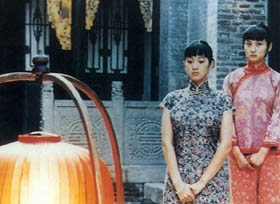 Before the midterm, we watched some films that were based on English-language novels. These films included Apocalypse Now, the 1944 Jane Eyre starring Orson Welles, and the 1999 David Copperfield with a very young Daniel Radcliffe. (Note: the version of David Copperfield that we saw was a TV miniseries and not intended for theatrical release.) However, English-language novels are not the only literary sources that filmmakers draw on!
Before the midterm, we watched some films that were based on English-language novels. These films included Apocalypse Now, the 1944 Jane Eyre starring Orson Welles, and the 1999 David Copperfield with a very young Daniel Radcliffe. (Note: the version of David Copperfield that we saw was a TV miniseries and not intended for theatrical release.) However, English-language novels are not the only literary sources that filmmakers draw on!One could also adapt a play by Shakespeare as director Franco Zeffirelli and two other authors did with The Taming of the Shrew in 1967. (Zeffirelli has also directed two direct adaptations of Shakespeare's plays: the 1968 Romeo and Juliet that you may have seen in high school as well as a 1990 Hamlet starring Mel Gibson as well as a 1996 theatrically-released version of Jane Eyre and film versions of various operas such as Otello and La Traviata.) Although, as we saw, The Taming of the Shrew was filmed in the studio, the set designer and the director did enough to counteract the staginess that older films based on plays often have. Many scenes take place outdoors. We first glimpse the "good" sister Bianca at a festival in the town square where students serenade her and lift up her veil. Later on, Kate and her bridal party wait for Petruchio on the stairs into the cathedral, and the newly married couple are caught in the rain. This film version contains a good deal of physical comedy as Petruchio pursues Kate, even on the rooftops, and they plunge into a bed of feathers. As Kate, Elizabeth Taylor rolls her eyes and sticks her tongue out at Richard Burton's Petruchio. Kate is introduced with a really intriguing shot as she looks out through a keyhole at her sister's would-be suitors. Later on there is another shot where Bianca looks out through a keyhole. I wish that we had been able to watch the scene where Kate gives her speech on a wife's duty. How did Ms. Taylor perform that speech?!
EN 202 being a course in world literature, we also watched Chinese director Zhang Yimou's Raise the Red Lantern, a film from 1991, just two years after the events in Beijing's Tiananmen Square. Raise the Red Lantern is based on Su Tong's 1990 novella Wives and Concubines. (I have just ordered this book from Amazon!) Zhang Yimou has also directed the historical films Red Sorghum and To Live as well as The House of Flying Daggers, a more action-oriented film. In Raise the Red Lantern, university student Songlian (played by Gong Li) travels to northern China to become the fourth wife (or Fourth Mistress) of Chen. She lives in a compound with Chen's other wives although each woman has her own house. This compound is in the country, but we do not see much of the countryside, except in the very beginning of the film as Songlian walks to the compound. The other wives are the older and psychologically distant First Mistress, mother of Chen's older son; Zhouyan, the second wife who appears to be very friendly and cheerful but is plotting against the others; and Meishan, a former opera singer who is the mother of Chen's younger son as well as the mistress of Doctor Gao. Raise the Red Lantern takes place in the 1920s, a time of unrest throughout China although the Chinese Civil War did not begin until 1927. The scene pictured above is of the lighting of the red lanterns, which signifies the house where Chen will spend the night. In the film, it is a family tradition; therefore, Chen does not wish to question it. Above Songlian is shown with her maid, Yan'er, who had had hopes of becoming the Fourth Mistress and, as we see, has hung red lanterns in her room. (Or has Chen hung them there?) After Songlian's ruse to feign pregnancy is discovered, and she betrays both Yan'er and Meishan, acts that result in their deaths, Songlian has a breakdown. In the next to last scene, she is observed by Chen's new bride, the Fifth Mistress.
What did you make of the ending to Raise the Red Lantern?
No comments:
Post a Comment